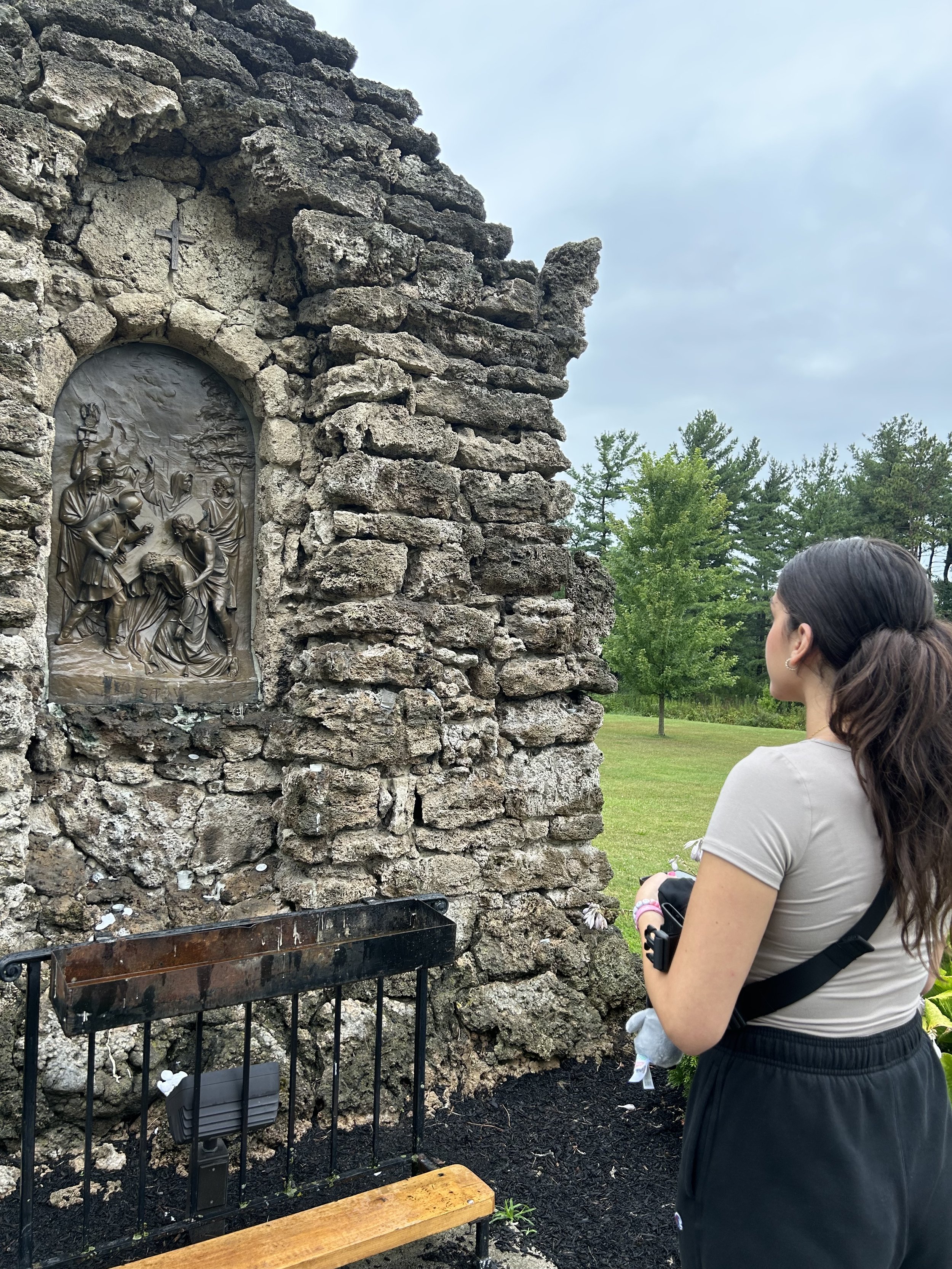Our Lady of Consolation Draws Loyal Followers




By Weam Namou
For nearly half a century, Chaldeans have been visiting the Basilica and National Shrine of Our Lady of Consolation in Carey, Ohio. It is the site of an annual pilgrimage of Roman Catholics, primarily Iraqi Christians, to mark the Feast of the Assumption of Mary, celebrated August 14, on the Eve of the Assumption.
On that day, several buses drop off pilgrims near the information center. Hundreds of families fill a five-acre plot with tents, recreational vehicles, Middle Eastern food, music, and dancing. Some families camp in the area for days, others spend the night at nearby hotels, and many drive to the site for only a day.
Approximately 5,000 visitors come every year. This year, the streets were a little quieter than usual due to the ongoing rain. Families huddled inside canopy tents or beneath canopied buildings. Campgrounds were filled with large mud puddles. Yet the weather did not prevent campers from barbecuing or gathering around campfires. The townspeople were also out and about. A mother and daughter sat on their porch passing out free bottled water and cookies.
Mass was held at various hours. Chaldean Masses were held at 12:30pm with Father Stephen Kallabat and at 5pm with Father Sameem Balius. At 9pm the Vigil Mass was celebrated with a candlelight procession to Shrine Park.
For over 150 years, the church has been a place of special importance, providing peace, warmth, and a consoling presence for believers. Yet few are aware of its history. Construction for the church—the first church in Carey—began in 1868. It was founded by people of Luxembourger heritage under the inspiration of an immigrant priest from the homeland. Luxembourg is one of the smallest countries in Europe and its people had for centuries fostered a deep devotion to the Mother of God.
While Father Aloys Fish was the first Conventual Franciscan to serve at the shrine, Father Joseph Peter Golden is considered the shrine’s “father.” He refused any salary from the congregation until the church building was finished. He and the people of Carey did all the work themselves, save plastering the wall. Once the church was completed, he encouraged the congregation in Carey to direct their prayers to Mary, the Mother of God, under the title of Our Lady of Consolation.
Father Golden later arranged for a statue to be made in Luxembourg, requesting that it would be as close a replica of the ancient image in the Cathedral as possible. At the end of March 1875, community member Nicholas Warnament brought this statue from Luxembourg to Carey; it was made of oak and could be dressed. Overjoyed, the parish asked Father Golden if they could carry the statue in procession from Frenchtown to the church in Carey.
Father Golden hesitated for some time. He feared a public expression might offend and anger the rather large Protestant population of Carey. He consulted several priests in nearby parishes, and they encouraged him to have the procession. So, he went ahead.
On May 24, 1875, the statue was carried in procession from the Church of St. Nicholas to the church in Carey. As the procession marched, a severe storm raged in the entire area. The story is that although people could see the rain pouring down on all sides of them for the entire seven-mile walk, not a drop touched the statue of Our Lady of Consolation, nor was anyone in the procession rained on. This was considered the first sign of an intercession of the Blessed Virgin for all who would come to pray in this little church.
The procession later moved to the Shrine Park altar where, in 1956, a 12-foot, 2-ton bronze statue of Our Lady of Consolation was placed on top of the dome of the altar, some 45 feet above the ground. The statue was made in Milan, Italy.
What began as an act of faith of an immigrant community connecting with their homeland has grown into a place where people of many ethnic and cultural backgrounds have come for pilgrimage. In Father Aloys Fish’s time, shrine manuals and devotional materials were printed in Hungarian, Polish, Slovak, Slovenian, and Italian. The Lebanese presence and the great crowds of Chaldean pilgrims have added their own traditions and cultural richness to the devotional life of the shrine over the years. So have Filipino, Hispanic, Albanian, Vietnamese, and African American pilgrims.
“This is my first year at the shrine and the first time I’ve interacted with Chaldeans,” said Friar Maximilian. “The only thing I knew about them before is that their liturgy is in Aramaic. I’ve had a good experience interacting with them. They are a kind and faith-filled people.”
The shrine complex includes the basilica, the original 1875 wooden parish church, the parish school, a rectory housing the pastor and other Franciscan priests, a provincial house which houses Franciscan friars, a convent for resident and visiting nuns, a retreat center providing lodgings for lay and religious pilgrims, a gift shop, and a cafeteria.
Friar Steven, who has served for some 40 years, was first introduced to Chaldeans when they started coming on pilgrimages. He learned more about them over the years, especially by interacting with one Chaldean family who became friends. They bought a house around the corner of the church where every year, the half-dozen siblings come for two weeks.
Friar Steven often goes into the camps and talks to people. “Sometimes there’s a language barrier,” he said, “but I honor their special relationship to this place which I myself have.”
